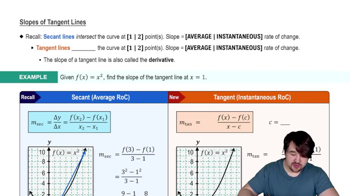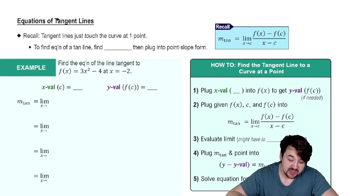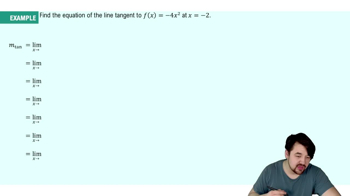Table of contents
- 0. Functions7h 52m
- Introduction to Functions16m
- Piecewise Functions10m
- Properties of Functions9m
- Common Functions1h 8m
- Transformations5m
- Combining Functions27m
- Exponent rules32m
- Exponential Functions28m
- Logarithmic Functions24m
- Properties of Logarithms34m
- Exponential & Logarithmic Equations35m
- Introduction to Trigonometric Functions38m
- Graphs of Trigonometric Functions44m
- Trigonometric Identities47m
- Inverse Trigonometric Functions48m
- 1. Limits and Continuity2h 2m
- 2. Intro to Derivatives1h 33m
- 3. Techniques of Differentiation3h 18m
- 4. Applications of Derivatives2h 38m
- 5. Graphical Applications of Derivatives6h 2m
- 6. Derivatives of Inverse, Exponential, & Logarithmic Functions2h 37m
- 7. Antiderivatives & Indefinite Integrals1h 26m
- 8. Definite Integrals4h 44m
- 9. Graphical Applications of Integrals2h 27m
- 10. Physics Applications of Integrals 2h 22m
2. Intro to Derivatives
Tangent Lines and Derivatives
Problem 3.10.61d
Textbook Question
Explain why or why not Determine whether the following statements are true and give an explanation or counterexample.
d. The lines tangent to the graph of y=sin x on the interval [−π/2,π/2] have a maximum slope of 1.
 Verified step by step guidance
Verified step by step guidance1
First, recall that the slope of the tangent line to the graph of a function y = f(x) at a point x is given by the derivative f'(x). For the function y = sin(x), the derivative is f'(x) = cos(x).
Next, consider the interval [−π/2, π/2]. We need to find the maximum value of the derivative f'(x) = cos(x) on this interval, as this will give us the maximum slope of the tangent lines.
The function cos(x) is continuous and differentiable on the interval [−π/2, π/2]. To find its maximum value, we can evaluate cos(x) at the critical points and endpoints of the interval.
The critical points occur where the derivative of cos(x), which is -sin(x), is zero. This happens when x = 0 within the interval [−π/2, π/2]. Evaluate cos(x) at x = 0, which gives cos(0) = 1.
Finally, evaluate cos(x) at the endpoints of the interval: cos(−π/2) = 0 and cos(π/2) = 0. Comparing these values, the maximum value of cos(x) on the interval [−π/2, π/2] is indeed 1, confirming that the maximum slope of the tangent lines is 1.
 Verified video answer for a similar problem:
Verified video answer for a similar problem:This video solution was recommended by our tutors as helpful for the problem above
Video duration:
1mPlay a video:
Was this helpful?
Key Concepts
Here are the essential concepts you must grasp in order to answer the question correctly.
Tangent Lines
A tangent line to a curve at a given point is a straight line that touches the curve at that point without crossing it. The slope of the tangent line represents the instantaneous rate of change of the function at that point. For the function y = sin x, the slope of the tangent line is given by its derivative, which is cos x.
Recommended video:

Slopes of Tangent Lines
Derivatives
The derivative of a function measures how the function's output value changes as its input value changes. For y = sin x, the derivative is cos x, which indicates the slope of the tangent line at any point x. Understanding the behavior of the derivative within a specific interval helps determine maximum and minimum slopes.
Recommended video:

Derivatives
Maximum and Minimum Values
In calculus, finding the maximum and minimum values of a function involves analyzing its critical points and endpoints within a given interval. For the function y = sin x on the interval [−π/2, π/2], we can evaluate the derivative to find where it reaches its highest value, which is essential for determining the maximum slope of the tangent lines.
Recommended video:

Average Value of a Function

 5:13m
5:13mWatch next
Master Slopes of Tangent Lines with a bite sized video explanation from Nick
Start learningRelated Videos
Related Practice



